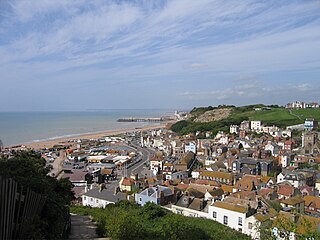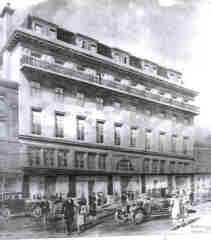
Alan Mathison Turing was an English mathematician, computer scientist, logician, cryptanalyst, philosopher and theoretical biologist. Turing was highly influential in the development of theoretical computer science, providing a formalisation of the concepts of algorithm and computation with the Turing machine, which can be considered a model of a general-purpose computer. He is widely considered to be the father of theoretical computer science and artificial intelligence.

Hastings is a seaside town and borough in East Sussex on the south coast of England, 24 mi (39 km) east of Lewes and 53 mi (85 km) south east of London. The town gives its name to the Battle of Hastings, which took place 8 mi (13 km) to the north-west at Senlac Hill in 1066. It later became one of the medieval Cinque Ports. In the 19th century, it was a popular seaside resort, as the railway allowed tourists and visitors to reach the town. Today, Hastings is a fishing port with the UK's largest beach-based fishing fleet. It has an estimated population of 91,100 as of 2021.

Polegate is a town and civil parish in the Wealden District of East Sussex, England, United Kingdom. It is located five miles (8 km) north of the seaside resort of Eastbourne and is part of the greater area of that town. Although once a railway settlement, its rail links were closed as part of the Beeching cuts. The 2011 census put the civil parish of Polegate at a population of 8,586, with 41.2% aged 65 and over.

St Leonards-on-Sea is a town and seaside resort in the Borough of Hastings in East Sussex, England. It has been part of the borough since the late 19th century and lies to the west of central Hastings. The original part of the settlement was laid out in the early 19th century as a new town: a place of elegant houses designed for the well-off; it also included a central public garden, a hotel, an archery, assembly rooms and a church. Today's St Leonards has extended well beyond that original design, although the original town still exists within it.

Henry Ward ARIBA was a British architect who designed many large public buildings in and around Hastings, East Sussex, some of which are listed buildings.

Hollington is a council estate and local government ward in the northwest of Hastings, in the Hastings district, in the county of East Sussex, England. The area lies next to Baldslow, Ashdown, North and Conquest, and less than five miles southeast of Battle, East Sussex, the home of Battle Abbey, which commemorates the victory of William the Conqueror at the Battle of Hastings in 1066.

Silverhill is a suburb and local government ward of Hastings, East Sussex, England. It has a central location within the town, where the A21 meets the B2159 road.

St Leonards-on-Sea Congregational Church is a former Congregational church in St Leonards-on-Sea, part of the town and borough of Hastings in East Sussex, England. Considered "one of the most ambitious Nonconformist buildings in Sussex", the sandstone building of 1863 forms a significant landmark on one of the Victorian resort's main roads—despite the loss of its copper spire in the Great Storm of 1987. Unlike most churches of its denomination, it did not join the United Reformed Church when that denomination was formed in 1972. It fell out of religious use in 2008 and had stood empty and was at risk of demolition. English Heritage has listed the building at Grade II for its architectural and historical importance. Bought by a new owner in 2012 it was almost completely renovated, but was then sold again in 2019. The new owner plans to open the church to the public as an arts and antiques centre with a cafe in the tower.

St Mary Magdalene's Church is a Greek Orthodox place of worship in St Leonards-on-Sea, a town and seaside resort which is part of the Borough of Hastings in East Sussex, England. Dedicated to Mary Magdalene and built in 1852 for Anglican worshippers in the growing new town of St Leonards-on-Sea, a seaside resort which had been laid out from the 1820s, the church's prominent position on the skyline overlooking the town was enhanced in 1872 by the addition of a tower. No longer required by the Anglican community in the 1980s, it was quickly bought by the Greek Orthodox Church and converted into a place of worship in accordance with their requirements. The alterations were minimal, though, and the building retains many of its original fittings and its "archaeologically correct Gothic" exterior which reflected architectural norms of the early Victorian era. English Heritage has listed the church at Grade II for its architectural and historical importance.

The Church of St Thomas of Canterbury and English Martyrs is the Roman Catholic church serving St Leonards-on-Sea, a town and seaside resort which is part of the Borough of Hastings in East Sussex, England. The present church, which combines a plain, unadorned Gothic Revival exterior with a lavishly decorated interior featuring extensive early 20th-century paintings by Nathaniel Westlake, is the third building used for Roman Catholic worship in the seaside resort. James Burton's new town of 1827, immediately west of Hastings, was home to a convent from 1848; public worship then transferred to a new church nearby in 1866. When this burnt down, prolific and "distinguished" architect Charles Alban Buckler designed a replacement. The church remains in use as the main place of worship in a parish which extends into nearby Hollington, and has been listed at Grade II by English Heritage for its architectural and historical importance.

St John the Evangelist's Church is the Anglican parish church of the Upper St Leonards area of St Leonards-on-Sea, a town and seaside resort which is part of the Borough of Hastings in East Sussex, England. The present building—a "very impressive and beautifully detailed" church in the Gothic Revival style, with a landmark tower—combines parts of Arthur Blomfield's 1881 church, wrecked during World War II, and Harry Stuart Goodhart-Rendel's 1950s rebuild. Two earlier churches on the site, the second possibly designed by Samuel Sanders Teulon, were themselves destroyed earlier in the 19th century. The rich internal fittings include a complete scheme of stained glass by Goodhart-Rendel's favoured designer Joseph Ledger and a 16th-century painting by Ortolano Ferrarese. English Heritage has listed the church at Grade II* for its architectural and historical importance.

Christ Church is an Anglican church in the town and seaside resort of St Leonards-on-Sea, part of the Borough of Hastings in East Sussex, England. Opened as the town's third Anglican church in 1860 to serve a rapidly developing residential area and to accommodate poor worshippers who could not afford pew rents at the fashionable St Leonard's and St Mary Magdalene's Churches, the original building was superseded by a much larger church built next to it between 1873 and 1875. Prolific ecclesiastical architect Sir Arthur Blomfield's simple Gothic Revival design forms a landmark on one of St Leonards-on-Sea's main roads, continues to serve a large area of the town and maintains a strong Anglo-Catholic tradition. It has been described as Blomfield's "finest achievement in Sussex" and "one of the main centres of Anglo-Catholic worship in Southern England". The interior fittings are the best of any church in the borough, and the design has been called one of Blomfield's most successful. St John the Evangelist's Church, founded as a daughter church nearby in 1865, also continues to thrive as a separate parish church. Historic England has listed Christ Church at Grade II* for its architectural and historical importance.

St Peter's Church is a former Anglican church in the Bohemia area of the town and seaside resort of St Leonards-on-Sea, part of the Borough of Hastings in East Sussex, England. Founded in 1883 in response to the rapid residential growth of this part of St Leonards-on-Sea, the "outstanding late Victorian church" was completed and opened in 1885. Architect James Brooks was towards the end of his career but still produced a successful, powerful Gothic Revival design, which was built by prolific local firm John Howell & Son—builders of several other churches in the area.

All Souls Church is a former Anglican church that served the Clive Vale suburb of Hastings, a seaside resort town and borough in the English county of East Sussex, between 1890 and 2007. The "large [and] serious town church" has been described as one of the best works by prolific ecclesiastical architect Arthur Blomfield. Built almost wholly of brick, inside and out, it dominates the streetscape of the late Victorian suburb and has a tall, "dramatic" interior displaying many of Blomfield's favourite architectural features. The church also has Heaton, Butler and Bayne stained glass and an elaborate reredos. Falling attendances and high maintenance costs caused it to close after a final service in November 2007, and the Diocese of Chichester officially declared it redundant soon afterwards. English Heritage has listed it at Grade II* for its architectural and historical importance.

Conquest Hospital is a National Health Service hospital in St Leonards-on-Sea in Hastings in East Sussex, England. It is managed by the East Sussex Healthcare NHS Trust.

Crown House is a residential building on the seafront of St Leonards-on-Sea, a 19th-century planned seaside resort on the coast of East Sussex, England. It was the first building completed in the town, which was planned and laid out by architect and property developer James Burton, and he used it as his own house. Intended as "a high-class watering place by the sea, along the best lines [and] for the best people", St Leonards-on-Sea was overshadowed by its larger neighbour Hastings and was merged into that town before the end of the 19th century, but Burton's venture was initially successful—particularly after a Royal visit in 1834–35 when the Duchess of Kent and the future Queen Victoria stayed at Crown House throughout the winter.

Robertson Street Congregational Church is a former United Reformed church in the centre of Hastings, a seaside town and borough in East Sussex, England. Built in 1885 on the site of an earlier church which had been constructed in 1857, it was designed by Henry Ward (1854–1927), who was responsible for many of the key buildings in the town of Hastings, not least the Town Hall. The building, a "large urban ... church with richly detailed exteriors and interiors", is situated between Robertson Street and Cambridge Road and has a split-level arrangement with part of the gallery occupying a flying freehold over the alleyway adjacent to the entrance on Robertson Street. The church is listed at Grade II for its architectural and historical importance.

St Leonards Pier, also known as the Palace Pier, was a public pleasure pier in St Leonards-on-Sea, part of the town and borough of Hastings in East Sussex, England. Opened in 1891 the pier was a direct rival to nearby Hastings Pier, and during its heyday the pier was a leading tourist attraction, and was described in the 1894 Baedeker travel guide as handsome. The pier was damaged during WW2 and left derelict after the war until purchased by Hastings Corporation in 1951 who demolished the structure over the next two years.



















